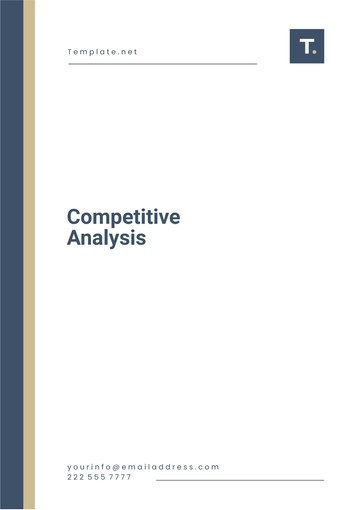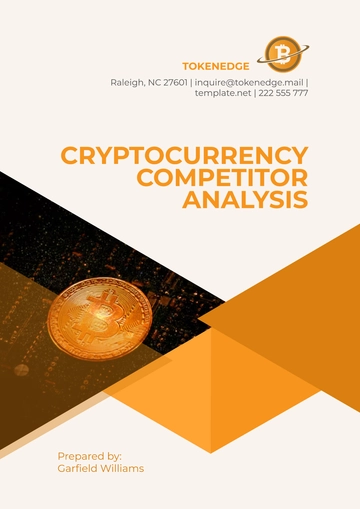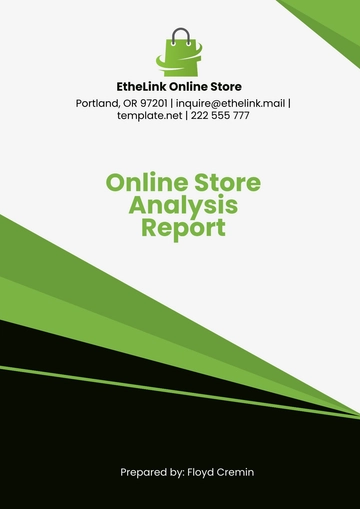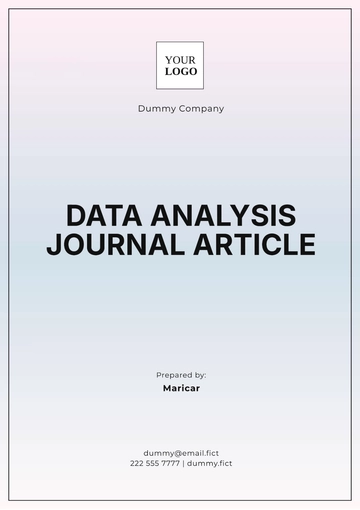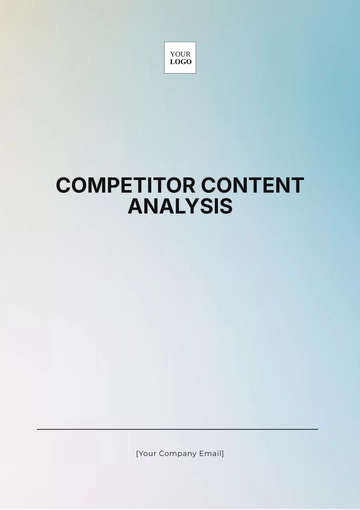Free Hotel Analysis Report

I. Executive Summary
[Your Company Name] conducted an exhaustive analysis of its hotel operations to garner comprehensive insights into its performance and growth opportunities. The report encapsulates an in-depth examination of market dynamics, financial performance, customer engagement, and strategic imperatives, aiming to position the hotel for sustained success in a competitive landscape.
The analysis underscores [Your Company Name]'s commitment to excellence, reflected in its prime location, diverse offerings, and unwavering focus on guest satisfaction. Leveraging a blend of qualitative and quantitative data, the report distills key findings and actionable recommendations to empower the hotel to navigate challenges, capitalize on opportunities, and unlock its full potential.
II. Introduction
A. Objective
At the heart of this report lies the objective to unearth the intricacies of [Your Company Name]'s operations and market positioning. By delving into performance metrics and industry benchmarks, the aim is to chart a strategic roadmap that aligns with organizational objectives, fosters innovation, and drives sustainable growth in a rapidly evolving landscape.
B. Scope
The scope of this report extends beyond mere performance evaluation; it encompasses a holistic evaluation of [Your Company Name]'s operational ecosystem. From dissecting market trends and competitive landscapes to scrutinizing financial metrics and customer sentiments, every facet is meticulously examined to provide a comprehensive understanding of the hotel's standing and prospects. The strategic recommendations that emerge are tailored to augment operational efficiency, enhance guest experiences, and fortify [Your Company Name]'s market position amidst dynamic industry shifts.
III. Market Overview
A. Industry Trends
The hotel industry is undergoing a paradigm shift driven by evolving consumer preferences and technological advancements. Noteworthy trends include a surge in experiential travel, the integration of smart technologies for personalized guest experiences, and an increasing emphasis on sustainable practices to minimize environmental impact and enhance brand reputation.
B. Competitive Landscape
[Your Company Name] operates within a fiercely competitive landscape characterized by a mix of global hotel chains, boutique establishments, and emerging hospitality concepts. Competitors vie for market share through innovative service offerings, strategic partnerships, and aggressive marketing tactics, necessitating a strategic approach to differentiation and value creation.
IV. Hotel Overview
A. Location and Accessibility
Strategically positioned in the heart of [City Name], [Your Company Name] benefits from unparalleled accessibility to key business districts, transportation hubs, and tourist attractions. Its central location serves as a magnet for both corporate travelers seeking convenience and leisure tourists craving immersive experiences amidst the urban landscape.
B. Facilities and Services
[Your Company Name] prides itself on offering a diverse array of facilities and services tailored to meet the discerning needs of its guests. From luxurious accommodations and state-of-the-art conference facilities to gourmet dining options and wellness amenities, the hotel epitomizes the epitome of hospitality excellence, ensuring unforgettable stays and seamless experiences for every guest.
C. Target Market
[Your Company Name] caters to a broad spectrum of clientele encompassing business executives, leisure travelers, families, and event organizers. By understanding the unique preferences and requirements of each segment, the hotel can tailor its offerings and marketing strategies to maximize revenue potential and foster lasting guest relationships.
V. Financial Performance
A. Revenue Analysis
In the fiscal year 2050, [Your Company Name] demonstrated impressive financial performance, achieving a total revenue of [$10,000,000]. This robust revenue generation was underpinned by the hotel's strategic focus on maximizing revenue streams across various areas of operation. A detailed breakdown of revenue sources is provided below:
Revenue Source | Amount | Contribution (%) |
|---|---|---|
Room Bookings | [$6,000,000] | [60%] |
Food and Beverage | [$2,500,000] | [25%] |
Event Hosting | [$1,000,000] | [10%] |
Other | [$500,000] | [5%] |
Room bookings emerged as the primary revenue driver, accounting for [60%] of the total revenue. This indicates the hotel's success in attracting guests and maintaining high occupancy rates throughout the year. Revenue from food and beverage sales and event hosting services also made substantial contributions to the overall revenue mix, highlighting the hotel's diversified revenue strategy and ability to capitalize on ancillary services.
B. Cost Analysis
[Your Company Name] adopts a comprehensive approach to cost management, recognizing the significance of controlling expenses to optimize profitability. The hotel's cost structure encompasses various components, including:
Staffing Expenses: [$3,000,000]
Utility Bills: [$800,000]
Maintenance Costs: [$500,000]
Marketing Expenditures: [$700,000]
Administrative Overhead: [$400,000]
By meticulously scrutinizing each cost element, [Your Company Name] identifies opportunities for efficiency gains and cost optimization. Implementing measures to minimize wastage, negotiate favorable vendor contracts, and streamline operations enables the hotel to maintain a competitive cost position while delivering exceptional guest experiences.
C. Profitability
Despite facing challenges such as rising operational costs and market volatility, [Your Company Name] remained resilient, achieving a commendable net profit of [$2,500,000] in the fiscal year 2050. This achievement underscores the hotel's ability to effectively manage expenses while driving revenue growth, resulting in sustainable profitability.
Maintaining profitability amidst a dynamic hospitality landscape underscores [Your Company Name]'s commitment to financial sustainability and operational excellence. By prioritizing prudent financial management practices and guest-centric service delivery, the hotel is well-positioned for continued success and growth in the competitive market.
VI. Customer Analysis
A. Demographic Breakdown
[Your Company Name]'s customer base exhibits remarkable diversity, spanning various demographic segments, including business travelers, vacationing families, solo adventurers, and group tourists. By segmenting its customer base and understanding their unique needs and preferences, the hotel can tailor its offerings and marketing strategies to enhance guest satisfaction and loyalty.
B. Customer Feedback
Customer feedback serves as a cornerstone of [Your Company Name]'s continuous improvement efforts, providing invaluable insights into guest experiences and pain points. Through structured surveys, online reviews, and direct interactions, the hotel solicits feedback on various aspects such as service quality, room cleanliness, dining experiences, and overall satisfaction, empowering it to address issues promptly and proactively.
C. Customer Satisfaction
Measuring customer satisfaction is paramount to [Your Company Name]'s commitment to delivering exceptional guest experiences. Key metrics such as Net Promoter Score (NPS), guest satisfaction surveys, and online ratings provide quantitative and qualitative assessments of guest sentiment. By benchmarking against industry standards and peer benchmarks, the hotel can identify areas of strength and opportunities for enhancement, thereby elevating overall guest satisfaction levels.
VII. SWOT Analysis
A. Strengths
Prime location in [City Name], offering unparalleled accessibility and convenience.
Diverse portfolio of facilities and services catering to the discerning needs of guests.
Strong brand equity and reputation for delivering exceptional hospitality experiences.
High levels of guest satisfaction and loyalty, evidenced by positive reviews and repeat business.
B. Weaknesses
Vulnerability to seasonal fluctuations in tourism demand, particularly during off-peak periods.
Reliance on third-party booking channels for revenue generation, leading to higher distribution costs.
Operational inefficiencies impacting cost management and resource allocation.
Limited market penetration in emerging customer segments, such as millennial travelers and experiential tourists.
C. Opportunities
Expansion into adjacent markets and untapped customer segments, including corporate retreats and destination weddings.
Introduction of innovative guest experiences and value-added services to differentiate from competitors.
Leveraging data analytics and personalization technologies to enhance guest engagement and loyalty.
Strategic collaborations with local businesses, tourism boards, and cultural institutions to create unique destination experiences.
D. Threats
Economic downturns and geopolitical uncertainties impacting consumer spending and travel behaviors.
Disruption from alternative lodging options, such as vacation rentals and peer-to-peer accommodations.
Regulatory changes and compliance requirements affecting operational costs and business continuity.
Intensified competition from established hotel chains and disruptive entrants leveraging alternative business models and distribution channels.
VIII. Recommendations
A. Strategic Initiatives
Diversification of Revenue Streams: Expand revenue sources beyond traditional room bookings by offering curated experiences, package deals, and ancillary services to capture a larger share of guest spend.
Strategic Partnerships: Forge strategic alliances with complementary businesses, such as local tour operators, airlines, and corporate entities, to tap into new customer segments and enhance brand visibility.
Investment in Technology: Embrace emerging technologies, such as artificial intelligence (AI), augmented reality (AR), and blockchain, to enhance operational efficiency, personalize guest experiences, and drive competitive differentiation.
International Expansion: Explore opportunities for international expansion into high-growth markets, leveraging franchising, management contracts, or joint venture partnerships to mitigate risks and accelerate growth.
B. Operational Improvements
Streamlined Processes: Conduct a comprehensive review of internal processes and workflows to identify bottlenecks, eliminate redundancies, and optimize resource allocation for enhanced operational efficiency.
Staff Training and Development: Invest in ongoing training and development programs to empower staff with the requisite skills, knowledge, and tools to deliver exceptional service and uphold brand standards.
Infrastructure Upgrades: Prioritize capital investments in infrastructure upgrades, maintenance initiatives, and sustainability measures to enhance guest comfort, safety, and environmental stewardship.
Quality Assurance: Implement robust quality assurance protocols and service standards to uphold consistency and excellence across all touchpoints of the guest journey.
C. Marketing Strategies
Targeted Marketing Campaigns: Leverage data-driven insights and segmentation strategies to craft targeted marketing campaigns tailored to specific customer segments, occasions, and preferences.
Digital Engagement: Enhance digital presence and engagement across multiple channels, including social media, search engines, OTAs, and review platforms, to amplify brand visibility, drive direct bookings, and foster guest loyalty.
Content Creation: Develop compelling storytelling narratives, user-generated content initiatives, and interactive multimedia experiences to captivate audiences, evoke emotions, and inspire travel aspirations.
Customer Relationship Management: Implement a robust CRM system to capture, analyze, and leverage guest data for personalized marketing communications, loyalty rewards, and repeat business stimulation.
IX. Conclusion
[Your Company Name] stands at a pivotal juncture poised for continued growth and success in the dynamic hospitality landscape. By capitalizing on its strengths, addressing weaknesses, seizing opportunities, and mitigating threats, the hotel can chart a path towards sustainable profitability, operational excellence, and guest-centric innovation.
- 100% Customizable, free editor
- Access 1 Million+ Templates, photo’s & graphics
- Download or share as a template
- Click and replace photos, graphics, text, backgrounds
- Resize, crop, AI write & more
- Access advanced editor
Gain insights and make informed decisions with our Hotel Analysis Report Template from Template.net. This customizable document allows hotel managers to analyze key performance indicators, trends, and competitive benchmarks. Customize to suit your hotel's analytical needs and drive strategic improvements and growth.
